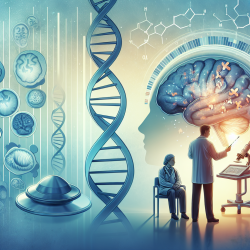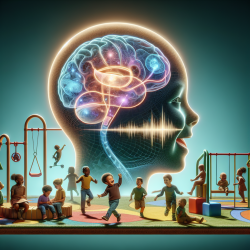Introduction
As practitioners in the field of speech-language pathology, it is essential to stay informed about the latest research findings that can impact our practice and the outcomes for the children we serve. A recent study titled Mutations in RAB39B in individuals with intellectual disability, autism spectrum disorder, and macrocephaly offers valuable insights into the genetic underpinnings of certain neurodevelopmental disorders. This blog aims to highlight key findings from this research and discuss how practitioners can apply this knowledge to improve their clinical practice.
Key Findings
The study investigated a family where two males with an inherited RAB39B mutation exhibited macrocephaly, intellectual disability (ID), and autism spectrum disorder (ASD). Their female sibling, carrying the same mutation, showed ID and a broad autism phenotype. Interestingly, their mother, who transmitted the mutation, did not have a neurodevelopmental diagnosis. This suggests a potential role of X chromosome inactivation in the expression of neurocognitive phenotypes.
The research utilized advanced techniques such as whole genome sequencing and cellular knockout models to explore the impact of RAB39B mutations on gene expression in neurons. The findings underscore the critical role of RAB39B in brain development and function, with a high penetrance for ASD among males but more variability among females.
Implications for Practice
Understanding the genetic basis of disorders like ASD and ID can significantly enhance our ability to tailor interventions to individual needs. Here are some ways practitioners can leverage these findings:
- Personalized Interventions: Recognizing the genetic components of a child's condition can guide the development of more personalized and effective therapy plans.
- Collaborative Care: Collaborate with geneticists and other healthcare professionals to provide comprehensive care that addresses both the genetic and behavioral aspects of a child's condition.
- Family Education: Educate families about the potential genetic factors influencing their child's development, helping them understand the importance of genetic testing and counseling.
- Further Research: Encourage ongoing research and participation in studies that explore the genetic factors of neurodevelopmental disorders, contributing to a broader understanding and better treatment options.
Encouraging Further Research
While the study provides significant insights, it also opens avenues for further research. Practitioners are encouraged to stay engaged with the latest research developments and consider participating in studies that explore the genetic aspects of neurodevelopmental disorders. Such involvement not only advances the field but also enhances the practitioner's ability to provide cutting-edge care.
Conclusion
The study on RAB39B mutations highlights the intricate relationship between genetics and neurodevelopmental disorders. By integrating these findings into clinical practice, practitioners can improve the quality of care and outcomes for children with conditions like ASD and ID. To delve deeper into the original research paper, please follow this link: Mutations in RAB39B in individuals with intellectual disability, autism spectrum disorder, and macrocephaly.










